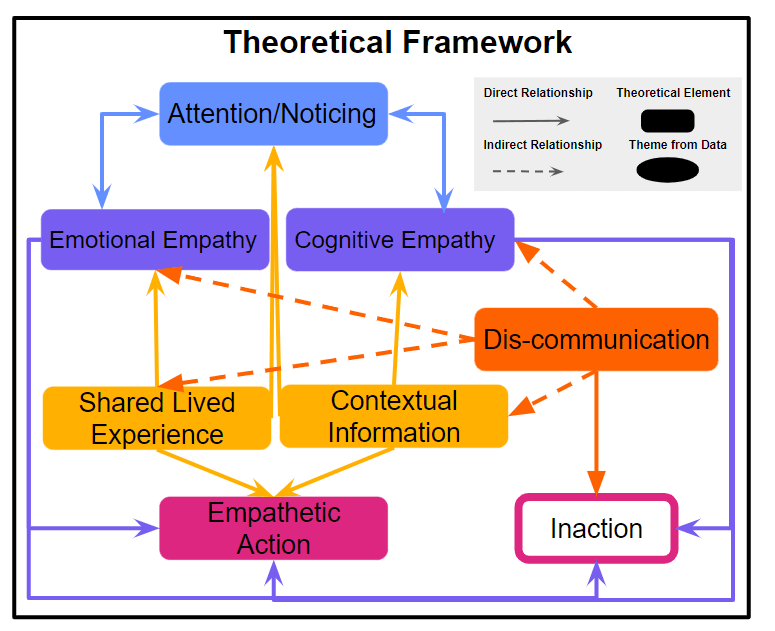Research Project
The role of empathy in faculty efforts to improve diversity, equity and inclusion in STEM environments
Principal Investigator(s)
Scott Franklin
Research Team Members
Postdocs:
Alia Hamdan
Undergraduates:
Ash Bista, Rachel Merrill (Currently attending Yale University)
Funding
Current Funding:
The Science and Mathematics Education Research Collaborative Postdoctoral Program, NSF Award 2222337 October 2022 - September 2025
Project Description
Impact
Efforts to increase diversity, equity, and inclusion, accessibility and justice (DEIAJ) in STEM spaces must include the faculty that teach students and supervise research, demonstrating and setting the culture. Faculty engagement with DEIAJ programming can stem from a variety of motivations, including past personal experiences with bias or prejudice or internal senses of justice. However, specific actions faculty can take to address individual needs rely on a complex intersection of cognitive (thinking) and emotional (feeling) empathy. This project studies how faculty perceive and engage with students and colleagues, exploring how faculty perceive the experiences of others and their resulting actions. Drawing on theories of empathy, the project seeks to understand when an intellectual or emotional understanding of another, results in, or fails to result in, a motivation to act.
Overview
The research is currently in an exploratory phase where we hope to gain a deeper understanding of the role empathy plays within physics departments, and how it can be co-created to develop more just spaces. We are still in the process of building out a more robust theory as outlined below. We hope this research develops into effective interventions that will help address issues of empathy within physics departments.
Research questions
Some of the research questions we are interested in pursuing are:
- How do physics faculty experience and apply empathy when interacting with their students, colleagues, and research mentees?
- How do students experience and build empathy when interacting with their faculty, colleagues and mentors?
- How do physics faculty (think/feel about and) perceive barriers to empathetic action, and why?
- What are the mechanisms used to communicate empathy for physics faculty and how do they develop? Are they different when co-creating empathy between faculty and students, colleagues, and research mentees?
Theory
This research is grounded in the theories of empathy. There is a growing body of research interested in investigating empathy from various disciplinary contexts yet there seems to be a general consensus on how empathy is conceptualized through these different disciplines. Eklund and Meranius (2021) congregated reviews from different disciplines to look for overall themes. It has generally been agreed upon that empathy is a multidimensional construct that has been defined as “the ability and tendency to share and understand others’ internal state” (Zaki & Ochsner, 2012). The two main dimensions of empathy that are generally agreed upon in the literature, are defined below:
- Cognitive Empathy: one’s ability to intellectually understand another person's perspective or emotions (Gladstein, 1983).
- Affective/Emotional Empathy: one’s ability to emotionally relate to the other person's experience or feelings (Gladstein, 1983).
Our research builds on these dimensions to understand the mechanisms in which one develops and sustains empathy. The following theoretical framework was developed through qualitative data, primarily focused on individual interviews of physics faculty [paper in prep].

An initial theoretical framework outlining the factors related to the different dimensions of empathy and the pathways leading to empathetic action or inaction. This framework was built on qualitative data collected from multiple interviews of Physics faculty members.
Each construct (Attention/noticing, Cognitive Empathy, Emotional empathy, and Empathetic Action) can further be broken down into their unique characteristics as follows:
- Attention noticing requires the ability to observe/ listen/ pay attention to the events beyond oneself. This is made easier with the presence of shared lived experiences and contextual information.
- Cognitive Empathy requires an understanding of others' experience while acknowledging it is not one’s own. Through contextual information one can also infer others thoughts and feelings.
- Emotional Empathy entails feeling with another person and sometimes causes one to mirror others emotional state. A shared experience leads to emotional empathy as one is able to remember their emotions when something similar occurred to them.
- Empathetic Action is the response one engages in after the development of empathy. Empathetic action is not always obtained and there are multiple barriers in place that might create an inaction like emotional strain, fear of causing harm to others, perception of the expectations of one's role, deciding inaction is in the best interest of the individual, and also one's own emotions toward a situation.